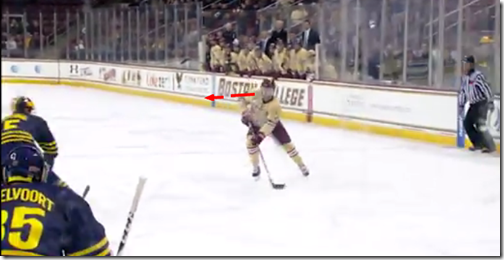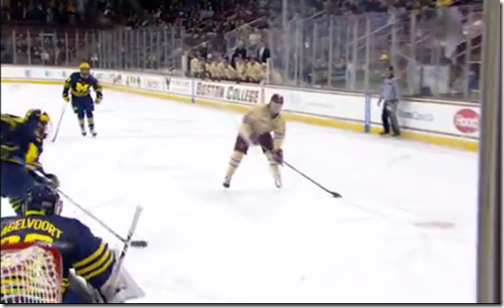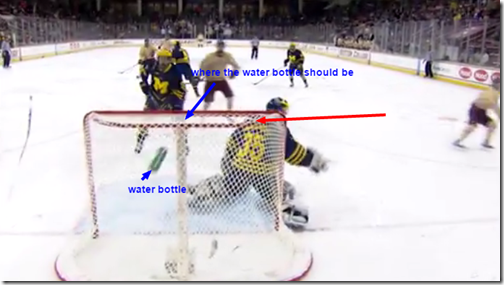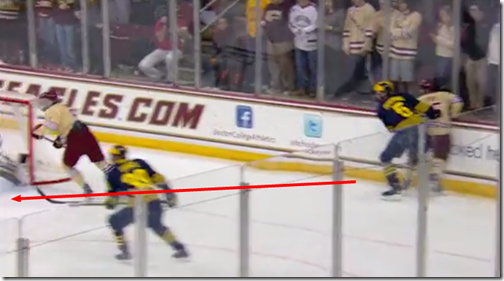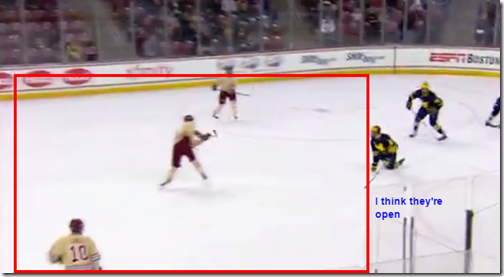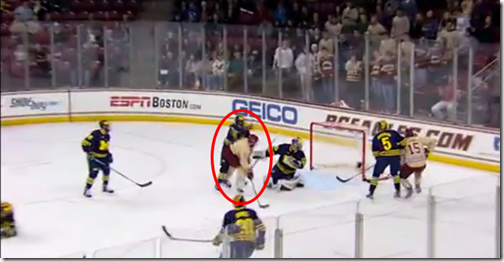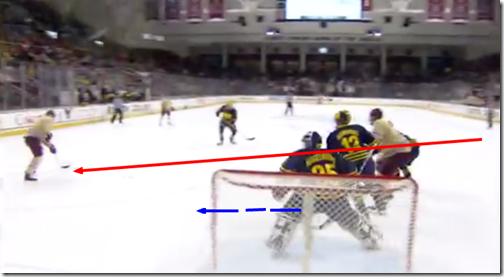1st period
Boston College 1 UM 0 EV 05:44 Doherty from Gilmour and Tuch
Teddy Doherty carries into BC’s offensive zone, and as he does this he starts to look to his right. Downing is back to defend and reads the tilt of Doherty’s head; he’s thinking pass and wants to take that away.
The thing is Doherty’s looking at no one. There’s not a BC teammate there for him to pass to, so he’s either going to shoot, turn it back and walk up the boards, or take it behind the net. You can see in the screencap that he’s going to shoot it. He’s loading up his shot, and Nagelvoort has a clear read on it.
Sometimes you lose a one-on-one battle. Sometimes a forward loses it along the boards. Sometimes a defenseman loses it in the neutral zone. Sometimes a goaltender loses it against a shooter. They all can be dangerous, but has as immediate an aftermath as a goaltender losing to a shooter. Nagelvoort butterflies and Doherty puts his shot in the perfect spot; it hits the top corner over the nearside shoulder.
It looks like this is Nagelvoort’s fault. In a way, it is. At the same time, he’s the last line of defense in what should be just that: a line. Downing is concerned with a backdoor cutter and plays the pass, which is textbook. The issue is that there isn’t a guy cutting that way. If he steps up to take Doherty he may not be able to put a body on him in time, but he takes away space from Doherty that he really shouldn’t have. Maybe this causes Doherty to choose one of the aforementioned options (skating it back up the boards or behind the net). My point is that a goal given up is not often solely one person’s fault, and there’s more than meets the eye here.
Boston College 2 UM 0 EV 07:42 McCoshen from Spiro and Gaudreau
Downing manages to pin Spiro along the boards, which is good. He manages to get a pass off into the slot, which is decidedly less good. Nothing terribly is necessarily going to come from this, but when you pin a guy along the boards the hope is that you tie the puck up along with it.
Passes in hockey are fast. You’re smart. You already knew that. It’s not completely unusual for a TV camera to snap forwards or backwards to keep up with the play, and that’s what happens here. One thing I’ve learned, though, is that you are in a world of trouble when the camera doesn’t have time to focus before the shot is off. That’s what happens here. Oy.
That screen cap looks worse than it is (maybe). There’s a strategy that teams use where the defense collapses around the goaltender, with the idea being that you’ll be able to pick up netfront opposition and clear the puck if there are rebounds. The downside to that strategy is this: a guy gets an undisturbed shot attempt that the goaltender can’t get a good read on, whether it’s because he’s being screened (see below) or whether he just can’t adjust quickly.
[After THE JUMP: I screencapped something that looks like hyperspace so that might be worth your time]
Boston College 3 UM 0 EV 14:03 Straight from Matheson and Tuch
Straight takes a pass that goes from near the blue line to the left faceoff circle. You can see Werenski and another Michigan defender bunched up in front of Nagelvoort. There’s no need to double team the screener here (or ever, really). Werenski should be over where I have the blue arrow pointing so that he can step up or try to block a shot from or try to do something, anything to Straight.
NO NO NO NOT THE UNFOCUSED CAMERA IT LOOKS LIKE HYPERSPACE SOMEONE MAKE IT STOP
2nd period
None
3rd period
Boston College 3 UM 1 PPG 03:38 Larkin (3) from Nieves (8) and Nagelvoort (2)
I have no video of this, but it happened. They were given six opportunities, and this was the only goal Michigan was able to score with the man advantage. The only video I was able to find from this weekend came from Boston College’s official site, and it’s the strangest highlight film I’ve seen. They didn’t include Michigan’s goal, but they did put in most of Michigan’s quality scoring opportunities. This is either good-job-good-effort level accidental trolling or somebody in their athletic department had a really good time making a passive-aggressive highlight film.
Boston College 4 UM 1 EV 12:51 Smith from Sit and Calnan
Smith skates in unimpeded, though Downing and Selman are nearby. They’re both trying to get close enough to make a play on either Smith or the puck, but neither can get there before he decides to shoot. The red box in the screencap just shows how much open ice there is in front of him. The logical choice for him is to shoot, because if he doesn’t Selman will be able to check him. His only other option is to dump the puck into the corner, but that’s less effective than just putting it on net.
The puck hits Nagelvoort’s shoulder and bounces over it and in, which…/heavy sigh. These kind of goals kill me. It’s hard to critique much (aside from what I noted above) because Nagelvoort was there and he stopped it and it took a strange bounce. That’s about it.
Boston College 5 UM 1 EN 18:43 Smith from Calnan and Matheson
Werenski thinks Smith is going to skate it in along the boards, but Smith pulls the puck across from his backhand to his forehand while Werenski’s back is turned. It’s a split-second decision, but Weresnki turning his back allows Smith to pull the puck across. If Werenski skates in backwards this likely doesn’t happen because Smith would have to pull the puck across an area where Werenski can easily poke check it away.
Werenski dives but can’t get his stick out in time to stop Smith’s empty-net chip shot.
NOTES
If you believe in karma balancing things out then I guess this was the return to the neutral state after the move into the positive that the Ohio State game provided. The final score was not entirely reflective of the game, but it’s all that matters. Michigan outshot BC 42-29, hit multiple posts (especially in the first period), and had six power play opportunities to BC’s three. The last goal was an empty netter, though the marginal pride of a three-goal loss instead of a four-goal loss is pretty slim.
The simple fact is that Michigan has been terrible away from Yost. I tend to ignore things like home and road records because I think they’re typically more narrative-driven than fact-driven, but at this point I think it’s worth delving into a little more. A 7-2-0 home record and a 1-5-0 road record makes Michigan appear to be a Jekyll and Hyde team; let’s see if the stats bear that out.
Michigan’s third in the nation in scoring at 3.87 goals scored/game. They’re 42nd in the nation in scoring defense at 3.07 goals allowed/game, so there’s a problem right off the bat. On the whole, Michigan has scored 12 more times than their opponents this season.
Things change when looking only at Michigan’s home games. They’re scoring 4.56 goals/game at Yost, good for first in the nation. They’re allowing 2.22 goals/game (23rd nationally) at home, a respectable and palatable number.
Michigan’s road game stats are about as miserable as you’d expect; 2.83 goals/game (25th nationally) scored and 4.33 goals/game (56th out of 59 teams in the country!) allowed. Something stinks and for once it’s not my four-month-old.
The rest of this is already difficult enough to digest, so let’s make it a little easier by putting it into a table. National rank is in parentheses:
| Stat | Home | Road |
| Power play % | 23.5 (15) | 14.8 (35) |
| Power play attempts | 34 (21) | 27 (34) |
| Penalty kill % | 84.8 (28) | 77.3 (49) |
| Penalty kill attempts | 33 (22) | 22 (47) |
| Shots on goal for/game | 36.0 (9) | 35.67 (2) |
| Shots on goal against/game | 28.11 (27) | 31.33 (35) |
| Faceoff win % | 58.2 (6) | 54.2 (4) |
| Blocked shots | 141 (5) | 75 (44) |
Michigan’s worse across the board when they’re on the road, with the exception of shots on goal for (they’re still technically getting more shots at home despite the lower national ranking). They’re allowing more shots against when they’re on the road, so even that’s sort of a Pyrrhic victory. There’s no easy explanation for this; the easy explanation is that Michigan’s worse on the road. Why they’re worse is a matter of debate.
What I can tell you from the watching them and using the eye test (/shudders) is that I don’t see one smoking gun. As a whole Michigan likes to take shots that are from the perimeter of the offensive zone, and you’re not likely to generate offense off of those. They fell victim to this over and over again at BC. It’s just not a good idea to try and beat goaltenders one-on-one all day; scoring comes off of screened shots and rebounds. Michigan did this well against Ohio State, and not just during their power-play-a-palooza portion of the game.
Going forward, Michigan’s going to have a very difficult (though, mercifully, neutral site) game against Mel Pearson’s Michigan Tech team in the first round of the Great Lakes Invitational. After that they’ll face either Michigan State or Ferris State before an early January home series against Minnesota, who sits 11th in the PairWise and RPI. On a macro level, Michigan needs to beat Michigan Tech (sixth in PariWise and RPI) and at least split the series against Minnesota to climb toward tournament contention. On a micro level, odd-man rushes against an an inability to cycle in the offensive zone continue to be an issue. If Michigan wants to avoid missing the tourney for a third straight year they’re going to have to take advantage of the neutral site and home opportunities they have over the next month.
